
Trend Analysis Using Moving Averages
Introduction
When it comes to analyzing financial data, one of the most commonly used tools is the moving average. Moving averages provide valuable insights into trends and help traders and investors make informed decisions. In this article, we will explore the concept of trend analysis using moving averages and how it can be applied to various markets.
Understanding Moving Averages
A moving average is a calculation that helps smooth out fluctuations in data over a specific period of time. It is calculated by taking the average of a set of data points within that time frame and updating it as new data becomes available. The resulting line, known as the moving average line, provides a clearer picture of the overall trend by reducing noise and short-term volatility.
Types of Moving Averages
There are different types of moving averages, but the two most commonly used are the simple moving average (SMA) and the exponential moving average (EMA).
Simple Moving Average (SMA)
The SMA is calculated by adding up the closing prices of a set number of periods and then dividing the sum by that number. For example, to calculate a 10-day SMA, you would add up the closing prices of the last 10 days and divide the sum by 10. The SMA gives equal weight to each data point in the calculation.
Exponential Moving Average (EMA)
The EMA, on the other hand, gives more weight to recent data points, making it more responsive to changes in the market. The calculation of the EMA includes a multiplier that exponentially decreases the weight of older data points. This means that the EMA reacts faster to price changes compared to the SMA.
Using Moving Averages for Trend Analysis
Moving averages are primarily used to identify trends and potential reversals in the market. By plotting the moving average line on a price chart, traders can visually analyze the direction of the trend and make decisions accordingly.
Identifying the Trend
When the price is consistently trading above the moving average line, it indicates an uptrend. Conversely, when the price is consistently trading below the moving average line, it suggests a downtrend. Traders often look for crossovers between different moving averages to confirm the strength of the trend.
Support and Resistance Levels
Moving averages can also act as support and resistance levels. In an uptrend, the moving average line often acts as a support level, where the price tends to bounce off before continuing its upward movement. In a downtrend, the moving average line acts as a resistance level, preventing the price from rising further.
Moving Average Convergence Divergence (MACD)
The MACD is a popular technical indicator that uses moving averages to generate trading signals. It consists of two lines: the MACD line and the signal line. When the MACD line crosses above the signal line, it generates a bullish signal, indicating a potential buying opportunity. Conversely, when the MACD line crosses below the signal line, it generates a bearish signal, suggesting a potential selling opportunity.
Conclusion
Moving averages are powerful tools for trend analysis and can provide valuable insights into market behavior. By understanding the different types of moving averages and how to interpret them, traders and investors can make more informed decisions and improve their overall trading strategies. Whether used alone or in conjunction with other technical indicators, moving averages are an essential tool in the financial analyst’s toolbox.





